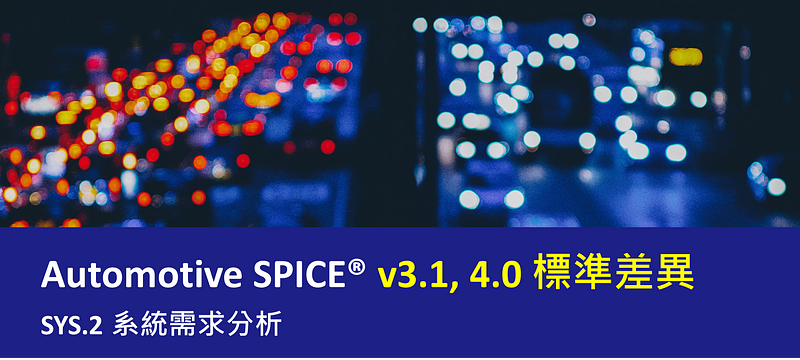本文為ASPICE v3.1與v4.0標準的差異性分析 — SYS.2 System Requirements Analysis 系統需求分析;本文章為「ASPICE v4.0 標準解讀」系列文章,筆者將針對ASPICE標準條文提供解讀與說明,期許本篇文章能夠為讀者,解決標準導入時的疑惑。
快速總結
1. ASPICE v4.0版,相較於ASPICE v3.1版,沒有太多差異。
2. 針對需求的驗證準則(Verification Criteria)變得更彈性,可視為一個選項,而非必要。
其他參照說明: ASPICE v4.0文章目錄 / (v4.0)ASPICE標準: SYS.2 系統需求分析
BP差異比對表
如上表,多數v3.1的BP(Base Practise)都有在新版的v4.0提到,其中三個主要差異如下:
(1) 需求制定的統合
筆者引述ASPICE Guideline 2.0的部分內文:
在ASPICE標準中(版本4.0之前),加入BP「Verification Criteria」的初衷是根據需求工程領域的最新理念,強調需求必須是可驗證的,否則就無法被視為真正的需求。
然而,這一做法卻引發了許多誤解。
誤解1: 評分上的不一致
在SYS.2及SWE.1的評鑑過程中,常見的問題如下:
BP1 明確指定需求: 評分為F BP5 定義驗證準則: 評分為N或P
這樣的評分顯示需求已撰寫,但其驗證準則卻未提及或有明顯缺漏。在這種情況下,若一個需求未能以可驗證的方式呈現,又如何能將其評為F呢?因此,存在相關的矛盾。
誤解2: 重複撰寫需求
BP中所提到的「Verification Criteria」似乎暗示著,要額外撰寫原有需求之外的資訊。然而,Verification Criteria實際上已經內含在需求陳述中,這導致內容的重複。
舉例來說:
The ECU shall be able to receive 100 to 110 bus messages within 1[s] with a tolerance of +0.2[s]
如果要針對這條需求額外撰寫「Verification Criteria」,則會發現這些驗證準則早已經被涵蓋在既有的需求中了。其中:
「... able to receive 100 to 110 bus messages ... 」提到驗證時的輸入範圍 「... within 1[s] with a tolerance of +0.2[s] 」提到驗證時的輸入限制(包含誤差範圍)
綜合結論
在最新版的標準中(即v4.0),將v3.1版本中的BP5的「Verification Criteria」概念,整合到BP1之中。專案團隊在制定需求時,需要確保需求本身是可驗證的,而撰寫「Verification Criteria」可以是一個簡易的確認方法。
(2) 「系統全景」取代「運作環境」
在ASPICE標準中(版本4.0之前),BP4多半強調要識別系統(產品)對外的介面,並針對該介面進行影響分析,在最新版的標準中,將運作環境(Operating environement)置換成系統全景(System Context),其概念是相似的。
所謂的「系統全景的影響分析」,意思是考慮「待開發產品」範圍之外的任何事物,也就是超出系統(產品)邊界的範疇。
筆者備註 值得一提的是,System Context在近幾年釋出的標準中,都有被提到: ISO 26262 Part 3, 概念階段時,需要釐清系統全景 ISO/SAE 21434 Clause 9, 概念階段時,需要釐清系統全景 IEC 62443-4-1 SR-1: 定義產品安全全景 新版的ASPICE置換用詞的用意,也是為了未來跟其他車用標準做整合。
(3) 合併追溯及一致性
在ASPICE v2.5時,追溯與一致性是合在同一個BP之中,然而該標準在業界採用時,常發生漏掉評估的問題,因此,在ASPICE v3.1版本時,特別將追溯性與一致性分開成兩個獨立的BP。
然而,分開成兩個BP也造成了誤解,導致以下結果:
追溯性 = F ; 一致性 = N 追溯性 = N; 一致性 = F
以上的結果,無論哪一個都呈現明顯的矛盾。在ASPICE模型中,強調資料之間的追溯性和一致性,事先必須確保追溯性才能確保後續的一致性。
在新版的ASPICE v4.0中,將追溯性和一致性合併為同一個基本原則,並再次強調,追溯性和一致性是密不可分的。
